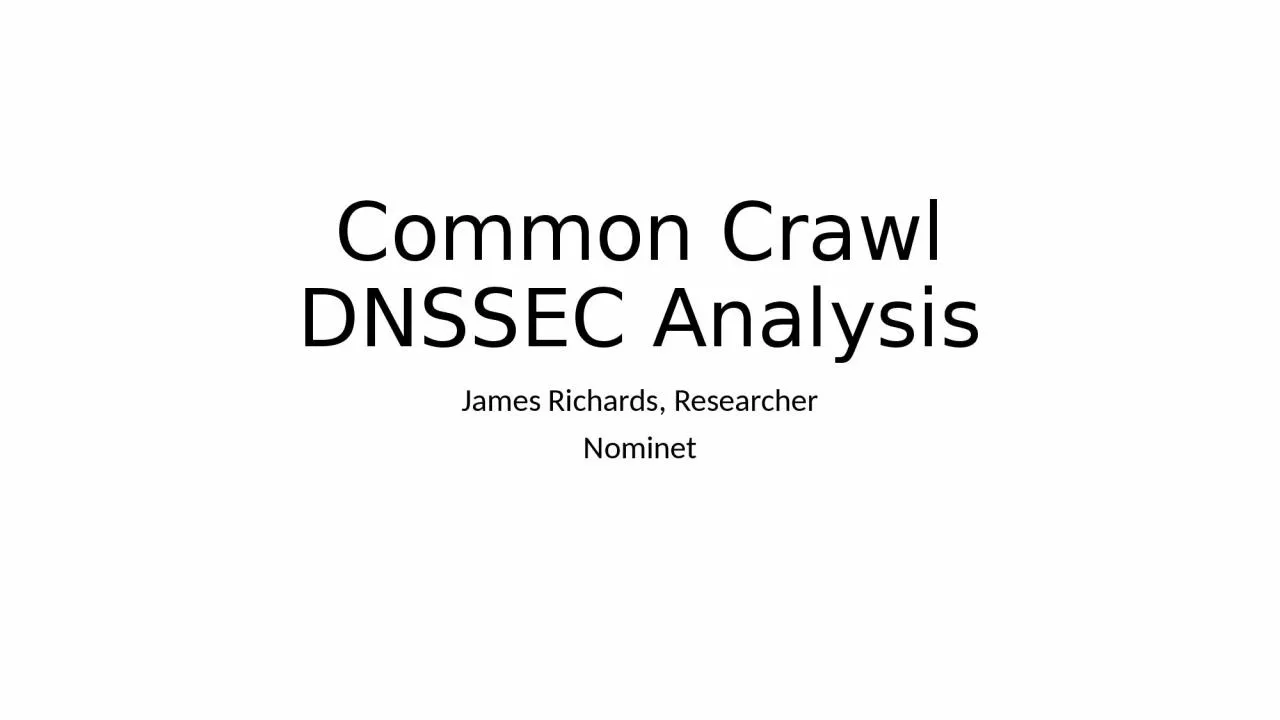

James Richards Researcher Nominet What are we studying Many DNSSEC deployment studies focus on lists of domains such as those occurring in popular lists or TLDs Users are rarely delivered website content from one single domain name often multiple domains are utilized ID: 1045794
Download Presentation The PPT/PDF document "Common Crawl DNSSEC Analysis" is the property of its rightful owner. Permission is granted to download and print the materials on this web site for personal, non-commercial use only, and to display it on your personal computer provided you do not modify the materials and that you retain all copyright notices contained in the materials. By downloading content from our website, you accept the terms of this agreement.
1. Common CrawlDNSSEC AnalysisJames Richards, ResearcherNominet
2. What are we studying?Many DNSSEC deployment studies focus on lists of domains such as those occurring in popular lists or TLDs.Users are rarely delivered website content from one single domain name – often multiple domains are utilizedHow do the DNSSSEC prevalence statistics change when all domains used to load content are considered?
3. DatasetCommon CrawlAmazon Public Datasets programJuly/August 2021 datasetWARC - Web Archive FormatWAT - WARC computed Metadata
4. AnalysisWe want to analyse domains used to deliver website content.This requires some judgementHyperlink [not content]Image[content]Script[content]Primary DomainContent Domain
5. AnalysisGrouped into categories using the Mozilla MDN elements reference, for example:Content sectioning (article, h1, h2, header, …)Image and multimedia (video, img, audio, ….)Scripting (script, canvas, …)...Tags not falling into an MDN category were assigned manually or given the label esotericOdd stuff:Websites with very high number of unique domains in the pageContent that doesn’t resolve (NxDomain, ServFail, Timeout)Sometimes difference between what is rendered in browser and the web scrape – a challenge we must live with for this study
6. Data Collection72,000 WAT files (21.67 TB) processed in batches in parallel:Download a file and iterate through it with warcioSelect domains under an ICANN suffix: nominet.ukSelect URLs at the root of a website: nominet.uk/Lookup A record for primary domain with DNSSEC OK bit setExtract domain names and tags from content in websiteLookup A record for content domain with DNSSEC OK bit setThrow away data that isn’t representative of content (a, area, p, mark, h, div, …)Make assumption that tags without domains are relatively referenced from primary domain e.g. <img src="/picture.jpg">nominet.uk<img src=”http://cdn.example.com/i-love-dns.png”><img src=”http://cdn.example.com/banner.png”><script src=http://example.com/script.js><h1>Nominet</h1><a href=“twitter.com”>Twitter</a>
7. Taking the right measurementsdomaindomain_adomain_rrsigdomain_algoelementclasscontent_domaincountcontent_domain_acontent_domain_rrsigcontent_domain_algonominet.ukYesYes13SCRIPT@/srcScriptingexample.com1YesNoNonenominet.ukYesYes13IMG@/srcImage and multimediacdn.example.com2YesNoNonenominet.uk<img src=”http://cdn.example.com/i-love-dns.png”><img src=”http://cdn.example.com/banner.png”><script src=http://example.com/script.js><h1>Nominet</h1><a href=“twitter.com”>Twitter</a>
8. High Level Statistics13.5 million websites analysed across 1113 different TLDs:com / org / net 58%country code TLDs 37%gTLDs / others 5%Contained 16 million content domains7.7% of the primary domains were signed and most used either algorithm 8 or 13
9. AnalysisUnsigned primary domains (92.3%)Unsigned DomainNo signed content78.23% Unsigned Domain1+ signed content14.11% Signed Domain1+ signed content6.08% Signed DomainFully signed content1.58% Signed primary domains (7.7%)
10. AnalysisTypically, how much of the website content is signed?Unsigned primary domains have content that is mostly under 10% signed.Signed primary domains have content that is much more likely to be signed including above 80% in many casesNumbers are driven by the primary domain which delivers content itself
11. AnalysisBrackets = (unique domains per category)
12. AnalysisBrackets = (unique domains per category)
13. AnalysisSome content domains are seen on many different websites. Not a surprise.The top 10 content domains are observed within 68% of websites in the datasetPopular content domains have significant influence on the whole dataset.Content DomainCountSigned<font cdn>6,434,507 No<popular website builder cdn domain>4,915,602 No<domain to deliver linked data schema>3,458,998 No<tracking>2,717,833 No<large tech company>1,328,860 No<popular script cdn domain>1,153,884 No<font cdn>1,046,510 No<tracking>979,022 No<popular cdn domain>890,003 Yes<large tech company>766,794 No
14. RedirectsWhat about HTTP redirects?Analysed 750k of the DNSSEC signed (primary) domains for redirects:0.09% of the DNSSEC signed domains redirected to a non-signed domainMuch better than I expectedProbably more work to do here around studying the how and why… and what about redirects on the content domains too?301
15. Conclusions and ThoughtsDNSSEC has higher impact on website delivery than raw DNSSEC deployment statistics suggest. What do we want to measure? some DNSSEC 21.77% ------- > 7.7% ------- > 1.58% all DNSSECWe rarely see signed domains use HTTP redirects to unsigned ones. Good!10 popular domains are observed in 68% of websites. Only one of these is signedDoes a website owner have complete control over all content in their domain being delivered with DNSSEC? Large enterprises running their own CDN, quite possibly. Smaller website owners who rely on common supply chains, potentially notImprovements:headless browser, scanning from user endpoints, more robust redirect analysis, closer coupling between web scrape and DNS data collection, more robust tag dictionary